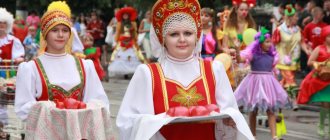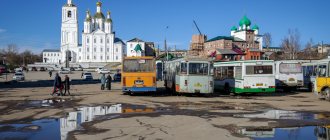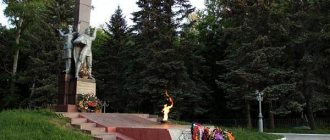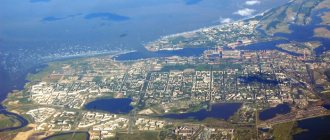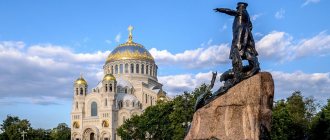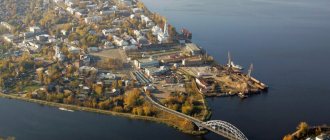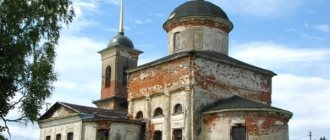The city of Elabuga is more than 1000 years old and everyone should visit there and touch the history of the region, which is an integral part of the history of Russia. Elabuga is located not far from Kazan (only 210 km). This is a small city, the historical part of which is located very compactly and holistically, and in which you can get acquainted with almost all historical monuments within one day. Therefore, Elabuga can be recommended for residents and guests of Kazan in the format - Weekend routes.
Description and history of Yelabuga
This is a small town near which the Ananyinsky burial ground was discovered. Its age exceeds 2.5 thousand years. This is the first open burial ground that revealed to the world a new archaeological culture - Ananyinskaya.
The history of Elabuga begins with the settlements of the Volga Bulgars in these places. This was in chapter X - beginning. XI century In the 16th century monks founded a monastery here, and later built the Trinity Monastery, surrounded on all sides by the village of Trekhsvyatsky. In 1780, the village received the status of a county town as a reward from Catherine the Great.
Gradually, Elabuga became a center of merchants, where 12 millionaires lived, and became one of the ten Russian cities with running water and electricity.
The bulk of the townspeople worked in factories producing:
- candles;
- bells;
- cast iron;
- beer;
- honey;
- flour;
- gingerbread;
- lard
The city has great cultural and historical significance, as it is associated with the names of famous people: poetess Marina Tsvetaeva, artist Ivan Shishkin, opera singer Azat Abbasov, cavalrywoman Nadezhda Durova, psychiatrist Vladimir Bekhterev and many others.
Elabuga, whose sights have a thousand-year history, ranks second in the country after the capital of Tatarstan in terms of the importance of historical and cultural heritage. Today about 74 thousand people live and work here.
Damn town
If you don’t know where to go in Elabuga to immerse yourself in the spirit of antiquity, we recommend starting with the Devil’s Settlement.
Story
At this site there was a large fortified settlement, which was created several thousand years ago. In the 11th century, the Bulgar feudal lord built a small fortress on the site of an ancient fortification. In 1236, after the invasion of the Tatar-Mongols, Volga Bulgaria fell and was included in the Golden Horde. The settlement was completely plundered and abandoned.
A new page in history began after Ivan the Terrible conquered the Kazan Khanate. In 1614, monk Ion Zeleny founded a monastery on the site of the former settlement. The Trinity Monastery existed until 1764, gradually expanding its territory. Not far from the hill a settlement was formed, it was called Podmanastyrsky, later the name was changed to Podmonastyrka.
There was a small village near the settlement; in 1780, by decree of Empress Catherine II, the village was given the status of a district town, part of the Vyatka province. The city began to be called “Elabuga” from the ancient “Alabuga”, but in honor of Catherine it was decided to change the first letter in the name to “E”. A few years later, Podmonastyrka Posad became part of the city.
After the monastery was closed and the monks left the site, it fell into disrepair. The surviving buildings were dismantled by local residents for building materials. In 1834, there was a lone tower here, and in 1844 its wall collapsed, and only the northern part remained.
In 1867, the merchant I.V. Shishkin, the father of the famous painter, saw his son’s sketches, which were made in 1855. After what he saw, I.V. Shishkin decides to completely reconstruct the structure. With his funds, the collapsed part of the tower was restored and an iron roof was laid. In this form, the building existed until the times of the Soviet Union.
After the collapse of the USSR, large-scale studies of archaeological sites began to be carried out on the territory of Tatarstan. Historians have identified the site as the remains of a mosque. In the 2000s, reconstruction was carried out, and in 2007 the settlement was included in the list of sites under UNESCO protection.
What can you see
During your visit, you will be able to see the ancient tower and walk around the settlement itself. From here you can see a picturesque view of the floodplain of the Kama River and the historical center of Yelabuga.
Interesting legends
Many tourists are interested in why the area is called that. According to one legend, during pagan times there lived a serpent-oracle, or simply the devil, here. He was famous for his predictions; people from all over the area came to him to find out their fate. He took human lives as payment. One day the serpent disappeared, and soon the Bulgarian kingdom was destroyed.
Top 10 most interesting attractions
Elabuga attracts the attention of tourists with its numerous historical and architectural monuments and natural beauty. Here you can visit houses where famous people lived, walk along the Alley of Lovers, visit museums, go to cathedrals and admire their beauty.
Elabuga settlement
Lovers of antiquity visiting Elabuga strive to see the famous archaeological complex, called the Old Town by locals. This place was once inhabited by the Volga Bulgars. Several legends have been written about it, one of which gave it another name - Devil's Settlement.
Of the entire settlement, only a stone tower remained. In the middle of the 19th century. it was partially destroyed. The arched opening above which the window was located remained intact. Thanks to I.V. Shishkin (the head of the city), the tower was restored a few years later.
Now this restored structure is covered with a new roof, has an entrance gate, and is surrounded by a small fence. Along the slope on which it is installed, there are walking paths for tourists and benches.
This architectural monument is included in the UNESCO World Heritage List.
Excursions are organized for visitors to the tower, during which the guide tells several beautiful legends about this ancient settlement. It also offers panoramic views of the city.
Ananyinsky burial ground
Another ancient monument is the Ananyinsky burial ground. It was opened in 1868 near the city. This happened by accident, when the waters of a river that overflowed in the spring washed away a four-meter hill, and human remains and objects of ancient life were found in the deep layers of the soil.
Numerous items found here have been added to the collections of several city museums and exhibitions. Some of them were sent abroad.
It was this historical find that gave birth to a new term - Ananyinskaya culture (era). When talking about this culture, experts mean the history of the development of the Middle Volga region from the end of the 9th to the 3rd centuries. BC. This place became the epicenter of excavations, the boundaries of which expanded by several kilometers.
At a distance of 11 km from the city, many artifacts (1,500 objects) were found that testify to the peculiarities of the cultural life of the ancient inhabitants - log dwellings, burial grounds, remains of fortifications, shrines. At the foot of the ancient hill, 2 stone boats were discovered, which served as the burial place of the rulers. There were also weapons and jewelry there.
Holy Key of Panteleimon the Healer
Numerous pilgrims often visit the spring, consecrated by the Orthodox Church, with natural water considered healing. He bears the name of Panteleimon the Healer.
The consecration of water occurs annually on the day of remembrance of this saint - August 9 - and on Epiphany. This natural monument is located near Elabuga and is protected by law. One of the famous natives of these places, the artist Ivan Shishkin, captured the source in his painting.
Anyone can draw holy water or bathe in the spring. There are swimming pools, stone paths, and benches and gazebos where you can relax.
Shishkinsky Ponds
One of the favorite vacation spots for residents and guests of Elabuga is Shishkinsky Ponds, named after their founder, the father of the famous artist. This is a recreation area in a picturesque place with numerous bodies of water (ponds, springs, fountains). In this park you can relax, sitting on benches or in a gazebo, walk along paved paths and openwork bridges, and admire the flower beds.
This place hosts city holiday events, fairs, exhibitions and sales of handicrafts, and performances by artists.
The park area includes:
- Stakheev embankment;
- Ushakov Square;
- Shishkin nursery.
Spassky Cathedral
The embankment of the city in its historical part is decorated with the Spassky Cathedral, which is more than 200 years old. Its height is 57 m, and architecturally it is an example of Russian classicism.
People come to the temple not only to pray, but also to admire the beauty of the interior decoration. The paintings on the walls are the result of the work of famous masters of the brush - I. Bruni and V. Vereshchagin. Icons and church utensils are decorated with gold, silver and precious stones.
In 2007, the cathedral was restored. Now it has 12 bells, the ringing of which attracts numerous visitors. Every year a bell ringing festival takes place here, in which masters from all over Russia demonstrate their skills.
Alexandrovsky Park
Alexander Park is the oldest of all city parks.
In connection with the coronation of Alexander II in 1856, a garden was laid out on this site. It was created according to the rules of English landscape architecture. There are clearings, small lawns, connected by winding paths. Visitors can spend time here relaxing in the gazebos or on benches in the shade of the trees.
Previously, the center of the park was decorated with a theater building and various attractions for children, a dance area and a fountain. Gradually, the park territory fell into disrepair, and only in 2010 did the park experience a rebirth.
Now it is a landscaped recreation area with asphalt paths, benches, lanterns and a new fountain. Every year the Descendants' Ball is held here, which brings together the descendants of famous people of the city.
Museum of County Medicine
Many of Elabuga's sights are associated with the names of famous people. One of them is V. Bekhterev. An outstanding neuropathologist, psychologist, and academician was born in this city. The unique Museum of County Medicine, located in the building of the zemstvo hospital, was named in his honor.
The museum exhibits tell about the historical development of healthcare in Elabuga.
Tourists can see here what they were like:
- a doctor's office in a county town;
- pharmacy;
- department for the treatment of children;
- operating room;
- ward for the mentally ill;
- house of a healer.
Local history complex
When the city turned 1000 years old, a local history complex was opened in the center, which is an architectural monument of the 19th century. Previously, the merchant Nikolaev lived in this building, combining eclecticism with baroque style.
The complex consists of several museums: one of them tells about the history of Yelabuga, the other houses the Tavern theater, where visitors can be fed delicious and simple food. The interior items in the Tavern were selected with a sense of humor and love for Russian history.
The complex has interactive workshops. Coming here, everyone has the opportunity to make any household item with their own hands, using folk crafts.
Elabuga masters give master classes on:
- making pottery;
- wicker weaving;
- embroidery;
- macrame;
- wood paintings;
- making souvenirs.
Here you can also buy ready-made goods. Parents with preschool children often come here to take their first craft lessons. The complex includes an exhibition hall designed for holding exhibitions, lectures and various presentations.
Memorial Trinity Cemetery
This place is part of the necropolis, where ordinary townspeople and famous personalities are buried, whose lives are connected with the history of the city. This memorial complex contains part of the preserved ancient church, ancient monuments and crypts, each of which is of historical value.
In the central part of the complex there is a monument to Nadezhda Durova, a famous woman who received the title of hero of the Patriotic War of 1812. The monument is made of green granite and is under state protection.
The merchants-philanthropists Stakheevs, known throughout Russia for their commercial successes, charity, and also made a significant contribution to the development of the cultural life of the city, are buried here.
Don't miss the most popular article in the section: Metro Nizhny Novgorod. Diagram, map, description.
Memorial complex of Marina Tsvetaeva
Despite the fact that the famous poetess did not live in Elabuga for long, the townspeople honor her memory. She died here, having lived in evacuation for less than a month. Her grave is located on the edge of the Peter and Paul Cemetery.
Not far from the house where Tsvetaeva lived with her son, there is a memorial complex, which includes:
- house of memory;
- literary museum;
- the square named after the poetess;
- cafe;
- Silver Age library;
- Portomoynya Museum.
The square is decorated with a bronze bust of Tsvetaeva, and the cafe often hosts memorial evenings and literary readings.
Shishkinsky Ponds
One of the main attractions of Yelabuga is Shishkinsky ponds. The complex is located on the banks of the Toima River, surrounded by picturesque vegetation. It includes a landscaped, landscaped park, an embankment, a public garden, and a nursery.
Story
The area was founded by Ivan Vasilyevich Shishkin, the father of the famous landscape artist I. I. Shishkin. Ivan Vasilyevich was not only a wealthy merchant, but also held a high position and twice became the head of the city. He loved Elabuga and invested a lot of money and effort into the development of his beloved city. Ivan Vasilyevich was not just a sponsor of numerous archaeological excavations, but he himself took a direct part in them.
In the mid-30s of the 19th century, he organized a spacious recreation area for citizens and guests of the city.
During the Soviet Union, the park area was abandoned and fell into disrepair. The development and reconstruction of the park's territory began only in 2007, for the city's anniversary. After careful work, the reservoirs began to work again, walking areas and places for recreation were installed. In addition, a large number of flowers and vegetation were planted.
What to see and do
After exploring the cultural sights of Yelabuga, go to Shishkinsky Ponds. Here you can walk through picturesque places, enjoying clean air and nature. Benches, benches, and paths are provided for comfortable relaxation. Fountains and ponds provide coolness even on the hottest day.
The park administration monitors order and cleanliness. City holidays and various special events are regularly held here. In the evenings you can attend performances by creative groups and musical groups. One of the brightest events is the Spasskaya Fair, during which you can not only see folklore performances, but also buy arts and crafts products.
Architectural objects and monuments of Elabuga
Not far from the Yelabuga settlement stands a 15-ton monument to Ibrahim I ben Muhammad, the Bulgarian emir who founded this city. He represents a horseman, dressed in the armor of a warrior and sitting on a war horse. The warrior points to the city. Its height is 17 m.
The earthen rampart surrounding the monument is part of an ancient fortification. The figure of the horseman is visible from passing steamships and from any part of the city, since he is mounted on a massive stone-boulder. A restaurant and an observation deck were built not far from it.
An architectural monument and the pride of Yelabuga is the university building, built in 1903 (architect I. Charushin) at the insistence of G. F. Stakheeva, who decided in this way to perpetuate the memory of her late husband, the merchant V. G. Stakheev. The university is located in the historical center of the city.
Especially durable brick was used in the construction of this three-story symmetrical building. During the laying of the foundation, one gold coin was placed under each corner of the future building. The decoration of the central risalit is distinguished by the Byzantine style, and the semicircular arched windows located on the additional floors of all risalits create a feeling of special representativeness of the building.
The Jamig Cathedral Mosque is an example of Muslim architecture. The mosque is located on the highest elevation in the city, which allows it to be seen from all points of the city. Its minaret reaches a height of 57 m, and the chandelier on the ceiling weighs half a ton.
The architecture of the mosque is dominated by oriental traditions, and its interior is decorated with 27 carpets woven in the traditions of Tajikistan. The mosque has a hotel with a teahouse, a garage and a house where the abbot lives.
Jamig Cathedral Mosque
One of the interesting objects not only in religious terms is the majestic Jamig Mosque. It is located on a hill, its top is the highest point in the city. The complex is a mixture of oriental architecture and the national characteristics of Tatarstan.
The prayer hall was first opened in 1995. The height of the minaret is 57 meters. The interior spaces are covered with 27 carpets, which were woven by craftsmen from the Leninabad region of the Republic of Tajikistan. One of the main decorations of the mosque is a massive chandelier weighing 500 kilograms. It was made by special order at the Saratov Glass Factory. 20,000 beads of different sizes serve as decoration.
Historical monuments of Yelabuga
The main historical and archaeological monument of federal significance is the Devil's Settlement, located on the right bank of the Kama. Here, on an area of more than 4 hectares, there was an ancient settlement.
Now there is a historical and archaeological complex with the remains of an ancient 7-meter citadel, ramparts and ditches. This place became the starting point in the development of modern Yelabuga.
The Church of the Great Martyr Barbara is another historical monument of Elabuga. It was built in 1887 and is part of the Kazan-Bogoroditsky convent. For a long time it did not function, but since 1995 it was consecrated and resumed work. Tourists and ordinary believers can attend the services that take place here every day.
In Elabuga there is a bronze monument to an unusual woman - cavalrywoman N. Durova, a native of this city, who participated in the battles of Gutshadt, Friedland, etc. It is located near the Trinity Cemetery on Kazanskaya Street. N. Durova is depicted in full growth, with full combat ammunition, sitting on a horse and holding a weapon in her hand.
Interesting museums in Yelabuga
Near the Spassky Cathedral on the Embankment there is a museum of the famous artist, whose life and work were connected with Yelabuga, Ivan Shishkin. The Russian artist was born in this building and lived until 1852. Coming here, you can plunge into the atmosphere of that time, see the interior of the rooms, including the master’s office, and look at the paintings in the gallery.
On M. Pokrovskaya Street there is the house-museum of M. I. Tsvetaeva. She came here after evacuating from Moscow. The poetess lived in the old house of the blacksmith Brodelshchikov for only 11 days, but the townspeople still remember and honor her.
A visit to the museum leaves an indelible impression of touching the beautiful and the tragic. There are some personal belongings of Tsvetaeva, volumes of her poems that make up a small exhibition, and poems are read. The suicide notes of this great woman leave no one indifferent.
In Elabuga there is a unique Museum of County Medicine named after Academician V. Bekhterev, which is located in the premises of a former neurological hospital.
Of scientific value are the articles by V. Bekhterev, published by him during his lifetime, books on medicine, and instruments that doctors once used. A separate exhibition is dedicated to the life and work of the academician, occupying an entire hall of the museum. There is a monument to him in the courtyard.
Visitors can use the interactive room and try tea brewed from medicinal herbs, find out their blood pressure, height and weight.
Elabuga
Elabuga (Tat. Alabuga, Alabuğa) is a city (since 1780) in Russia, the administrative center of the Elabuga municipal district of Tatarstan, part of the polycentric Nizhne-Kama (Naberezhnye Chelny) agglomeration and the Nizhne-Kama territorial-production complex-node (TPK).
Elabuga is one of the oldest settlements in Tatarstan with a 1000-year history. The city's millennium was celebrated in 2007.
Immersed in greenery, the city with a panorama of churches and ancient stone mansions is an example of merchant architecture of the 19th century, which has preserved its unique appearance and landscape. It is located among forests on the high right bank of the Kama at the confluence of the Toyma River, 200 km east of the capital of the republic, Kazan.
Area - 41.1 km². The seventh most populous city in Tatarstan with a population of 73,333 people. (2016). A large industrial center that is dynamically developing thanks to one of the first special economic zones of the industrial production type in Russia, “Alabuga”.
By Order of the Government of the Russian Federation dated July 29, 2014 No. 1398-r “On approval of the list of single-industry towns,” the city was included in the category “Single-industry municipalities of the Russian Federation (single-industry towns) in which there are risks of deterioration of the socio-economic situation.”
The history of Yelabuga in the depths of centuries.
An entire era in archeology received its name thanks to the discovery of the Ananyinsky burial ground near Yelabuga, dating back to the 8th-5th centuries. BC e. Based on complex archaeological and historical data, taking into account the frequency of coincidence of expert assessments of the chronology of dating finds from the oldest layer of the Elabuga settlement and the adjacent settlement, taking into account the conclusions of the leading scientific centers of the Russian Federation, the scientific council of the Institute of History of the Academy of Sciences of the Republic of Tatarstan determined that Elabuga arose at the turn of the 10th-11th centuries and formed as an urban-type settlement by 1005-1010. The mysterious tower of the Yelabuga “Devil’s” settlement is a witness to the events of the Middle Ages.
Since ancient times, there was a summer-winter crossing over the Kama River here. During the Bulgarian period, it became an integral part of the trade and caravan road from the central regions of Volga Bulgaria to the Middle and Upper Kama region (towards the vis) and further to the Arctic Ocean. In the 12th century. a white stone mosque (Ak-mosque) with eight towers and half-towers was built, structurally similar to the cathedral mosques in Bilyar-Bolgar (IX-XX centuries) and Bolgar (XIII-XIV centuries) and having the closest analogues in mosque-fortresses in Sousse (Tunisia) and Baghdad (Iraq). Currently, the remains of this mosque-castle are the only partially preserved Bulgarian above-ground structure of the pre-Mongol era. Archaeological excavations in recent years have yielded interesting results that allow us to consider ancient Alabuga among the Bulgar cities that existed in the pre-Mongol period of our history. In the 9th-10th centuries AD. e. The Bulgarian state was formed, the most valuable monument of which is the “Elabuga settlement” - the remains of the ancient Bulgarian city. One of the towers of the ancient fortress, restored in the 1860s, is a place of pilgrimage for believers, city guests, and tourists.
Foundation of the village of Trekhsvyatskoe
After the fall of the Kazan kingdom, a monastic monastery was built on the site of the Yelabuga Devil's settlement in 1614. In 1616, the construction of the Trinity Monastery and its churches was completed on this site, but it did not last long and was abolished in 1764. The founding of the village of Trekhsvyatsky dates back to around the time of the creation of the monastery, so the notes of the famous Prince Kurbsky mention the campaign against the Kama, carried out by the Russians shortly after the conquest of Kazan by Tsar Ivan IV Vasilyevich the Terrible. In the book of the Big Drawing, compiled in the first quarter of the 17th century, Tryokhsvyatskoe is mentioned as follows: “and below the Ika River 40 miles on the Kama River, the city of Chertov is also Yelabuga.” There is an assumption that after the founding of the village of Trekhsvyatskoye and the first Church of the Intercession, Tsar Ivan Vasilyevich, by whose order the Church of the Intercession was founded, the image of the Three Saints was granted to the Church of the Intercession, which is why Elabuga began to be called the village of Trekhsvyatskoye. The image of the Three Saints is still kept in the Church of the Intercession in the city of Elabuga; its painting has not suffered at all and belongs to the ancient Greek style. From the time of the granting of the icon of the Three Saints by Tsar John IV to the Church of the Intercession, the village of Tryokhsvyatskoye was called “Trohsvyatskoye, Elabuga also.”
Formation of the city.
In 1780, a decree of Empress Catherine II was promulgated, according to which Elabuga received the status of a county town in the Vyatka province. At that time, about 1000 residents lived in Elabuga and there were less than 400 houses.
The second half of the 19th century was the period of formation and flourishing of the Ushkov dynasty of merchants and industrialists. It was the Ushkovs who were the founders of chemical plants in the Kama region. The first chemical plant was built by K. Ya. Ushkov in Kokshan in 1850; in the 1890s, both in the diversity and size of its production and in the exemplary organization of its business, it took almost the first place among all Russian chemical plants.
At the beginning of the 20th century, the city of Elabuga already had 10,000 residents, of which more than 600 were merchants, including 12 millionaires. The most famous dynasty of merchants, the Stakheevs, the largest trading houses “I. G. Stakheev and sons", "G. I. Stakheev and Heirs” had an annual turnover of up to 150 million rubles, supplied bread to various regions of Russia, as well as to England, Germany, France, Holland, and Belgium. The entire grain market of the Kama region was in their hands. Their powerful family relied on enormous capital. They had gold mines in Western Siberia, oil fields, their own shipping companies, plants and factories. The trade and purchasing activities of the Girbasov merchants were also well organized. Trading house "F. P. Girbasov and his sons annually purchased 510 thousand pounds of bread. The Girbasovs also had their own exchanges. Bread was sold in Rybinsk, Nizhny Novgorod and St. Petersburg.
In the documents of the Russian population census, a tsarist official wrote in 1904: “The citizens of the city are famous for their charity. It is difficult to point out another district city where charity would be shown on such a large scale as in Yelabuga. The Yelabuga merchants, distinguished by their charity from time immemorial, built churches at their own expense both in the city and in other places of the empire...” In Yelabuga, from the 1870s until 1917, there was a special “Charity of citizens I.I. and D.I. Stakheev Committee,” whose huge funds were directed exclusively to helping people. In addition to the Stakheevsky charitable committee, which had more than 2 million rubles in its accounts in 1904, there was also a committee created by analogy of the merchant Chernov, which also owned significant capital, with interest from which churches were built in various parishes.
Civil War
On March 6, 1917, the 230th reserve infantry regiment stationed in Yelabuga elected a new commander. At the request of the regiment soldiers, the regimental commander, Lieutenant Colonel Lukashevich, was replaced by Captain Drozdin.
After the October Revolution in Petrograd, a change of power began in the country. In Yelabuga, this process took place in difficult conditions. The seizure of power was carried out by the workers of the Bondyuzh chemical plant, and they were led by the Bolshevik S.N. Gassar.
The Yelabuga merchants, and above all the Stakheevs, stubbornly resisted the rebels. They received constant assistance from the monarchist-minded officers of the 230th Infantry Reserve Regiment, located in Yelabuga.
On November 16, 1917, the district congress of peasant deputies decided to transfer power to the Soviets. The Bolsheviks elected the Yelabuga District Council, of which Gassar became its chairman. Under his leadership, the property of local merchants was nationalized and plundered by workers.
On February 24, 1918, Archpriest of the Spassky Cathedral P.V. Dernov and his three sons were shot in Yelabuga - they were accused of organizing a counter-revolutionary rebellion in Yelabuga.
In May 1918, the executive committee of the Yelabuga Council adopted a resolution that stated: “... consider the Syugin glass factory nationalized, for which we ask for the sanction of the Supreme Council of the National Economy.” At the same time, the uprising of the Czechoslovak Corps against the Bolsheviks began in Chelyabinsk. The Czechoslovak offensive received the support of the Socialist Revolutionaries, who created a Committee in Samara from deputies of the Constituent Assembly (part of the People's Army KOMUCH).
In the summer of 1918, a peasant self-defense detachment was formed in Yelabuga, operating against the Bolsheviks. It was headed by a participant in the 1st World War, Lieutenant Colonel Viktorin Mikhailovich Molchanov. The successes of the detachment led to the fact that it grew to 9 thousand people and V. M. Molchanov became the head of all armed formations in the district.
In July-August, part of the People's Army of KOMUCH V.O. Kappel made its way through Bugulma to Simbirsk (07/22/1918) and together they marched on Saratov and Kazan. They moved west, they occupied cities one after another: July 5 - Ufa, July 7 - Bugulma, August 6 - Kazan, August 17 - Menzelinsk.
By the evening of August 18, a detachment of Red Guards under the command of A. M. Zhelezkin took Menzelinsk with a strike from Sarapul through Pyany Bor. Fighting took place in the area of the villages of Baysarovo, Poisevo, and Matveevka with varying degrees of success. The detachments of the People's Army of KOMUCH moved the center of the offensive to the western direction. On September 7, 1918, they broke through to Elabuga on three armed ships and occupied the city.
In the fall, under pressure from the Red Guard units, Molchanov’s detachment, reduced to 4 thousand people, received an order to retreat to Ufa.
In October 1918, after parts of the Russian Army of Admiral A.V. Kolchak entered Yelabuga, L.A. Govorov, with the rank of second lieutenant, was mobilized into the White Army and enlisted in the battery of the 8th Kama Rifle Division of the 2nd Ufa Army housings.
April 25, 1919 - the battle of the Kokshansky plant near Elabuga, the 58th Akmola Rifle Regiment of Kolchak’s army opposed the Reds.
On May 2, 1919, Elabuga was occupied by Kolchak’s army. The White Guards restored the tsarist administration.
In May-June 1919, battles were fought by the river fleet on the Kama. On May 24, 1919, in the area of Cape Svyatoy Klyuch, the largest clash took place between the flotillas of the opposing sides, in which victory remained on the side of the white flotilla. The commander of the Red Flotilla, independently, without taking into account the operational situation and the organization of interaction with the advancing 28th Division of the 2nd Army, decided to shell the city of Yelabuga. The 2nd and 4th divisions of the Volga Military Flotilla came out to shell the city and the nearby highway. Meanwhile, the ships of the 1st and 3rd divisions of the River Combat Flotilla, fulfilling the operational order of the commander of the Siberian Army No. 24, concentrated in Yelabuga at dawn on May 24.
Fearing encirclement, detachments of A.V. Kolchak’s army left Naberezhnye Chelny on May 14, Menzelinsk on May 17, and Yelabuga on May 25. The advancing units of the 2nd Red Army of the Eastern Front occupied Yelabuga on May 26-27.
In July 1919, N.K. Krupskaya visited Elabuga during a cruise. She carried out a mission of revolutionary agitation among the population of settlements liberated from units of the White Army.
USSR
In 1921, in connection with the formation of national autonomies, the Elabuga district was divided into two parts: the southern - Elabuga canton - was transferred to the Tatar Autonomous Soviet Socialist Republic, and the northern - Mozhginsky district - to the Votskaya Autonomous Okrug.
From 1921 to 1928, Elabuga was the center of the Elabuga canton, from August 10, 1930, the center of the Elabuga region of the Tatar Autonomous Soviet Socialist Republic.
During the Great Patriotic War, a branch of Leningrad State University under the leadership of Academician V. A. Ambartsumyan was evacuated (from 1941 to 1944). Among the employees of the branch were V. I. Smirnov, V. A. Fok, V. V. Sobolev (later academicians). At the same time, part of the cotton factory evacuated from the city of Vyshny Volochyok was located in Yelabuga. The poetess Marina Tsvetaeva lived here and committed suicide on August 31, 1941.
In the post-war period, large oil fields were discovered near the city. New fields were discovered - Pervomaiskoye, Elabuga, Krasnoborskoye, etc. In 1961, the sixth oil and gas production department in Tatarstan, Prikamneft, was organized in Elabuga.
In 1985, the leadership of the USSR decided to create a dual-use Kama Tractor Technical Plant near the city of Yelabuga and the Kama River to produce tractors and (if necessary) tanks. Due to the decreased national economic and military-strategic need for them and the presence of unsatisfied more pressing needs of the country's population, the plant being created was converted into the Elabuga Passenger Car Plant (ElAZ) in 1988. Equal in scale to AvtoVAZ, ElAZ was supposed to produce 900 thousand per year of minicar VAZ-1111 “Kama”, its employees and their families were supposed to sharply increase the population of Yelabuga to 300-400 thousand people (making it the third largest city in the republic), and A high-speed tram was to be launched from the new residential areas of Yelabuga to the industrial site of the plant and to Naberezhnye Chelny. Due to the collapse of the planned socialist economy and then the collapse of the USSR, ElAZ was later implemented not in its intended form, but in small-scale licensed production of foreign cars (VAZ-1111 cars were produced on a smaller scale at other car factories, including ZMA in neighboring Naberezhnye Chelny).
Post-Soviet time
In 2005, at the proposal of the leadership of Tatarstan, the Government of Russia, in order to organize the most favorable conditions for the implementation of large investment projects by Russian and foreign companies at the large-scale ElAZ site near the city, a special economic zone "Alabuga" was founded, one of the first such industrial-production zones in the country. with the expanding production of cars and components, various equipment and instruments, processing of chemical and agricultural raw materials, etc.
On August 24-26, 2007, the millennium of Yelabuga, the second settlement in Tatarstan after its capital, was widely celebrated on a Russian scale. For the anniversary, several important facilities were built and reconstructed in the city.
Source: https://ru.wikipedia.org/wiki/%D0%95%D0%BB%D0%B0%D0%B1%D1%83%D0%B3%D0%B0
Temples and cathedrals of Elabuga
Elabuga, whose attractions will satisfy any interest, is an example of an organic combination of Christian and Muslim traditions. There are temples and monasteries here where you can learn about the characteristics of the two religions.
The Kazan-Bogoroditsky convent in Yelabuga, judging by various sources, was built in 1850 or 1868. By the end of the 19th century. More than 300 nuns lived and worked there. They made candles, painted, sewed, and worked in the garden and on the farm.
The monastery was closed at the beginning of the twentieth century, and during the Great Patriotic War and after its end, prisoners of war lived here, and later there was a library and training rooms for the NKVD.
The second life of the monastery began in 1995 after restoration. Nowadays, divine services are held here at 8 a.m. and 4 p.m. every day. In the center of the city is located the Church of St. Nicholas the Wonderworker, no less attractive for tourists. It owes its appearance to the well-known merchant and philanthropist A. Stakheev in the city.
The uniqueness of the temple lies in some architectural features, not always traditional for religious buildings of that time:
- lack of apse;
- rectangular shape of the altar;
- one dome.
The temple building was built in the style of Russian classicism. The interior decoration was done by famous masters - artists V. Vereshchagin and P. Pervunin.
Representatives of the Muslim faith can visit the highest mosque, Jamig, which is an example of Muslim culture. The two-color facade, rich carpets and beautiful decorations make the temple unique and majestic. In addition, in Elabuga there are the Nur and Al-Qadir mosques, Ikhlas and Shatlyk are under construction.
What else can you see in Yelabuga
Of course, you can’t pass by the Spassky Cathedral
(Embankment, 14), built in the style of classicism. The white-stone, five-domed church with a 70-meter bell tower is, as it were, a symbol of the entire city architecture. The first bell for the bell tower was cast by the grandfather of the artist Shishkin. And the altar wall of the cathedral is the chapel of Alexander Nevsky - an example of provincial architecture.
Not far away there is another architectural monument of strict classicism - the stone St. Nicholas Church
(Embankment, 58), built on the site of an earlier wooden building from the mid-17th century. The current church was built at the expense of the merchant A.I. Stakheev. The interior was very richly decorated thanks to donations from the city's merchants. The painting of the church was carried out by the artist V. Vereshchagin.
On Spasskaya Square, not far from the Cathedral, there are Western shopping arcades
(B. Pokrovskaya), built according to the type of the St. Petersburg trading yard. Currently, this building belongs to the Suvorov Military School.
On Bolshaya Pokrovskaya there is also the building of the former first district school - the House of A. I. Stakheev
. (B. Pokrovskaya, 9). Stakheev bought this building after the fire in 1850. and built a tenement house in it. And in memory of the fact that there was previously an educational institution here, bas-reliefs depicting Lomonosov were sculpted between the first and second floors.
The Church of the Intercession is also interesting
or the Intercession Cathedral (B. Pokrovskaya, 42). It is the historical heir of the first wooden church of Elabuga, or rather not yet Elabuga, but the village of Trekhsvyatskoye. The last (third) building of the early 19th century combines elements of classicism, baroque and empire style. The main iconostasis was made by the Vereshchagin brothers. In this, now restored, church, a memorial service for Marina Tsvetaeva is held annually on August 31.
Parks and natural attractions of Elabuga
Elabuga, whose attractions amaze with their diversity, provides citizens and tourists with numerous places for recreation and walks. One of them is the unique Lantern Park, a kind of gift from neighboring Bugulma. Here you can see a variety of street lamps and relax sitting on benches.
Not far from the Devil's Settlement there is a park founded in honor of the 1000th anniversary of Yelabuga. People come here to admire the apple blossoms in the spring and enjoy delicious fruits in the fall. There are many flower beds and an observation deck.
Lovers of folk crafts love to visit the Shishkinsky Ponds Park, where an annual exhibition of works by craftsmen demonstrates their talent in pottery, embroidery, making souvenirs from various materials, sewing, and carpet weaving.
Modern objects interesting to visit
Elabuga is a city where history and culture are revered. In 2015, the Memory Museum was opened here, which presents exhibits telling about the life of the city during the Great Patriotic War and the contribution of local residents to the victory over fascism.
The museum contains documents of those times, weapons, photographic materials, and belongings of soldiers. Here, in a recreated dugout, you can take a photo while trying on a soldier’s costume.
For art lovers there is an Exhibition Hall in Yelabuga. This building once belonged to the merchant A. Nikolaev, now paintings by contemporary artists are exhibited here, meetings with interesting people, music evenings, and conferences are organized. For those interested, master classes are held on teaching the art of drawing and making arts and crafts.
In 2016, the city recreated Pioneer Park on a once abandoned area. Couples with children come here to play on the playground. For lovers of active games, quests are held here weekly.
The city has its own Big Ben. This is a clock that is located in the central part of Yelabuga and is made after the example of the famous London tower. From below, this structure is made of red marble, merging into a two-tone white and green flooring. There are 4 dials, “looking” at the four cardinal directions. Visitors can stay in hotels and hotel complexes in Elabuga.
The most popular are:
| Hotel and restaurant complex "Shishkin" |
|
| Hotel "Blackberry2" |
|
| Hostel "Visit" |
|
| Guest house Gor.ka |
|
All hotels have free Wi-Fi and parking.
Top 5 places suitable for holidays with children
Elabuga is a city that can interest adults and children with its attractions. For tourists with children, there is a large selection of places to visit.
Pets' corner
Children will be interested in visiting the living corner located in the Museum of the City History. Kids can interact with animals, feed and care for them. There are guinea pigs, Chilean squirrels, hamsters, chinchillas, turtles and fish.
In the zoo corner, children will be told about the fauna of Yelabuga and shown photographs of the inhabitants of the surrounding nature.
Far Far Away kingdom
Arriving at the Lower Kama Nature Reserve, children will have the opportunity to find themselves in a fairy tale. Here there is the Far Far Away Kingdom with a real magical forest in which the heroes of famous fairy tales live. Those entering the forest are greeted by a fairy-tale king with his retinue.
Koschey, Baba Yaga and other interactive characters live in the forest. Children can ride bicycles, scooters, buy various souvenirs and ride a horse.
Ice Palace
The Ice Palace in Yelabuga is a place for lovers of active recreation. At any time of the year, you can go ice skating here, get a master class, and young residents of the city can sign up for a hockey or figure skating section. Competitions are often held at the Palace; the hall seats 1,370. There is a gym, a hotel, and a cafe.
Children's entertainment
There is a children's entertainment center on Mira Avenue. Here kids can ride on slides, swings or children's cars, jump on a trampoline, and wander through the maze. This is the best place for children's birthday parties.
There are animators working in the center; birthday guests can enjoy a disco with soap bubbles, the opportunity to paint their faces with face painting and try a beautiful birthday cake.
Spasskaya Fair
Those who come to Yelabuga in August should visit the Spasskaya Fair. Adults and children here will be interested in seeing performances by musicians, a farce show, watching an exhibition of arts and crafts, and buying a souvenir.
As part of this annual event, the bell ringing festival takes place here and is an unforgettable experience.
What time is best to come to Yelabuga?
If your arrival in Yelabuga is in the spring, then you will be taken to the fun Maslenitsa festivities, which take place at the beginning of March. Hot pancakes and horse riding are guaranteed. In April you will be able to attend the Poetry Festival, dedicated annually to the work of G. Tukay. And in May, of course, it’s Victory Day, as well as the Colors of Life International Film Festival.
If you are planning your trip for the summer, then at the beginning of June there is the national Tatar holiday Sabantuy, accompanied by theatrical performances, folk games and competitions. Or you can combine your visit with the time of the All-Russian Spasskaya Fair from July 31 to August 2. The Bell Ringing Festival is also held at the same time. And at the end of August (31) is the Memorial Day of Marina Tsvetaeva, which is accompanied by the reading of poetry, the performance of songs and romances.
Elabuga in autumn is poetic and beautiful. At this time of year, you can take amazing pictures in Alexander Park and Shishkinsky Ponds.
Winter Elabuga is covered with lush snowdrifts, which means that a trip at this time of year is a wonderful opportunity to go sledding from the hills near the Devil's Settlement or on the Shishkinsky Ponds. If fate brought you to Yelabuga from December 15 to 24, then you will be able to see the theatrical program “Fun of a Merchant City”.
But no matter what time of year you choose, no matter what time of year you decide to come for 1 or 2 days, what sights you decide to visit, what route you take to walk around the city - know for sure that you will not be disappointed!
Self-guided walking route in 1 day
Elabuga, which has attractions in all its districts, allows you to enjoy their beauty while walking.
The most interesting route for lovers of leisurely walks:
- The beginning of the path is Kazanskaya street. Here you can visit the house-museum of Marina Tsvetaeva.
- Walking along the street. Spasskaya, and then along the Embankment, you can come to the Spassky Cathedral and climb the bell tower.
- Next to the cathedral there is a museum-theater “Tavern”, where you can relax and have lunch.
The Tavern Museum-Theater will not only feed the guests of Elabuga, but also show interesting shows - Returning to the Embankment, you can get acquainted with the work of the artist I. Shishkin by visiting the museum.
- You can relax and see a lot of interesting things at Shishkinsky Ponds.
- Not far from Shishkinsky Ponds there is a spring, from where a staircase leads travelers to the historical and architectural monument - the Devil's Settlement.
- After an exciting journey, tired tourists can gain strength in the Gorodishche restaurant (Millennium Square).
- You can finish your walking tour in the Alexander Garden.
Kazanskaya street
Every city has central streets where cultural life is concentrated. In the historical part of Yelabuga there is Kazanskaya Street - the heart of the city. Along it there are numerous cultural and historical sites. A favorite place for the promenade among residents and guests of the city, it is fraught with the charm and spirit of the 19th century.
Story
The street was founded by order of Catherine II in 1784. Initially, only commercial establishments were erected here, distinguished by their massive and pompous architecture. Subsequently, a decision was made to erect other buildings.
Kazanskaya Street is an avenue surrounded by picturesque parks, green areas and recreational areas. Ancient 19th-century mansions, squares, monuments and original sculptures combine into a single whole with the natural beauty of the surrounding area.
What to see
During the walk, you can not only cafe and taste traditional dishes, aromatic drinks and fluffy desserts, but also see several interesting objects.
Merchants' houses - along the street there are several mansions in which wealthy merchants lived. One of these buildings houses a branch of the federal university.
Monuments – here you can see a monument to Stakheev, a representative of the famous merchant family. A little further there is a diminutive copy of the Kremlin wall. One of the favorite attractions of Elabuga among romantics is the bench for lovers. The theme park of lanterns and the monument to the Signalman and the Postman deserve special attention.
Among the attractions and decorations of Kazanskaya Street is the literary museum of Marina Tsvetaeva, as well as a square and monument dedicated to the poetess.
Interesting Facts
Elabuga is an ancient city that keeps many secrets of history and is famous for its attractions.
Some interesting facts:
- Elabuga is one of the few cities that is more than 1000 years old.
- This is the birthplace of the world famous artist I. Shishkin.
- Marina Tsvetaeva committed suicide here, having lived in the city for only 11 days.
- It is believed that the city existed in the pre-Mongol period.
- The population of the city is multinational, Russians make up 50%, the rest are Mordvins, Tatars, Chuvashs and other nationalities.
- Here ended the life of N. Durova, the famous “cavalry maiden”, whom her mother threw out of her carriage as a child, and was picked up and raised by the hussars.
Elabuga is a unique town that has preserved the architectural and historical appearance of merchant life in the 19th century. There are many attractions here that are connected with history and the names of famous people.
People of different nationalities and religions coexist peacefully in the city; people come here to relax, enjoy the unique landscapes and learn many interesting historical facts.
Article design: Mila Friedan
